It is believed that a white head indicates a person’s advanced age, but many are concerned about the question: “Why does the hair on the head turn gray at the age of 30?” No one wants to grow old prematurely, especially the fair sex. What is causing the problem? Scientists do not have a definite answer, but they were able to identify a number of reasons that provoke the appearance of gray hair.
Age phenomenon
Gray hair can be divided into 2 types: early (before 35 years) and age (after 35). The appearance of white hairs at the age of 40 is a natural phenomenon associated with a decrease in the production of pigment substances and deterioration in nutrition of the scalp. The answer to the question: “Why does hair turn gray?” is simple. And without lengthy introductions, it is clear that after 40 this is an age-related phenomenon. In this case, you can only adjust the color with food and various masks. A well-designed diet will slow down the process of hair lightening. But over time they will still become ashy.

Why does hair turn gray at an early age?
If for people after 35 the appearance of “ash” on the head is quite expected, then for younger people this is not a completely normal process. What can cause hair discoloration in young people, teenagers and even children?
- Various diseases.
- Genetic predisposition.
- Wrong lifestyle.
- Unhealthy eating.
- Increased psycho-emotional stress, neuroses.
- Frequent dieting.
- Bad habits.
All this leads to various disruptions in the body, which provokes such a reaction.
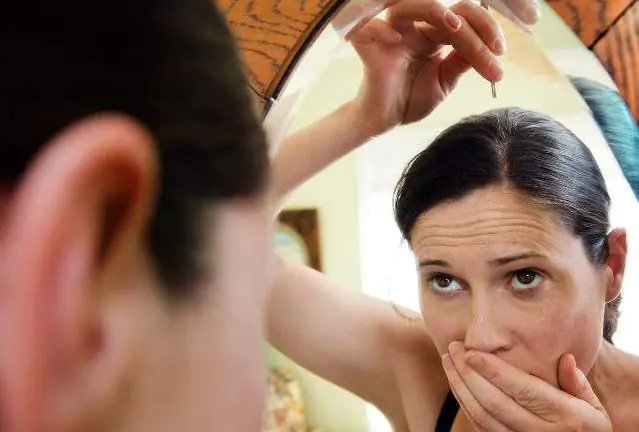
Diseases
One of the main reasons why hair turns gray at an early age is various viral or chronic diseases. Disturbances in metabolic processes are especially dangerous in this sense, since the body begins to work somewhat differently. Diseases of the internal organs and glands lead to disruptions in the body. Taking medications can also cause some complications. The main diseases that one way or another can lead to early gray hair:
- Any problems with the cardiovascular system impair blood supply to all organs.
- Disturbances in the functioning of the endocrine glands.
- Diseases of the nervous system.
- Incorrect functioning of the gastrointestinal tract.
- Some viruses.
- Anemia.
- Avitaminosis.
Therefore, if you are concerned not only about rapid hair discoloration, but also about any other symptoms, you need to undergo an examination to determine the cause of the disease.
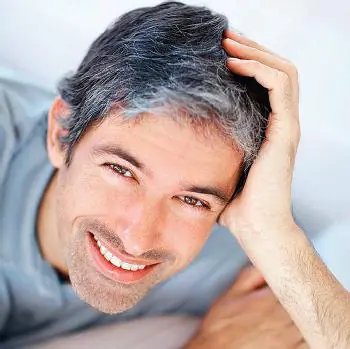
Lifestyle
If a person is as healthy as an ox and the reason does not lie in any diseases, then it is possible that he is abusing his good condition. Does not follow a daily routine, eats on the go and snacks on fast food, does not sleep for days. Young people also have frequent parties in clubs, drinks and cigarettes, and then sleepless nights before a session or defense of a course or dissertation. This attitude towards one’s own health leads to various unpleasant consequences. As a result, young people begin to notice that their complexion has changed, their nails have begun to peel, and their hair has lost its shine. Girls are especially susceptible to such changes, and they are more likely than guys to wonder why their hair turns gray at 25. In this case, it is necessary to urgently change their lifestyle. It is possible that the process will stop and hair coloring will have to be postponed.
Poor nutrition
If the diet lacks vitamins and microelements, the outer skin is always the first to react. The body begins to save a little. This is why hair turns gray. 30 years is no longer the age when the body is able to endure various hardships without consequences. For example, with a lack of vitamins, hair becomes brittle, it begins to lose its shine, silkiness and color. Therefore, it is important to maintain a balanced diet and eat fresh fruits and vegetables every day. Don't forget about proteins.
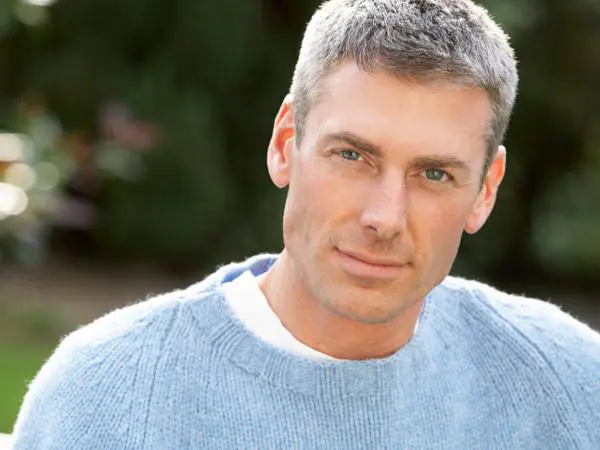
Diets
This is a special case of malnutrition. Many have had to deal with hair loss while following diets of varying degrees of severity. This is caused by the fact that the body lacks vitamins and microelements. Diet regimens that exclude protein have become very popular. Hair may not fall out, but tyrosine stops entering the body and melanin production decreases, which leads to early whiteness of the head. Complete fasting also has its pitfalls, in particular, it can lead to exhaustion of the body, and this will provoke hair loss and graying. Girls who want to lose weight are at great risk.
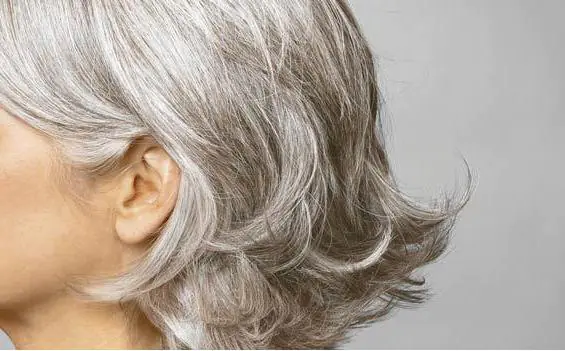
Stress
This is an indirect reason why hair turns gray at age 30, but at the same time one of the most common. The fact is that with regular increased stress, overwork, neurosis, etc., the processes of melanin production are disrupted, which leads to lightening of the head. For this reason, the stronger half of humanity most often turns gray.
No hats
Such a fashionable trend among girls now - walking with uncovered hair at any time of the year - can lead to sad consequences. This is one of the leading reasons why hair turns gray. Under the influence of sunlight, pigment substances are destroyed. Many people have probably noticed that over the summer their hair becomes lighter and fades. With prolonged and regular exposure to ultraviolet radiation, the beautiful color will remain only memories and that very gray hair that everyone wants to get rid of.
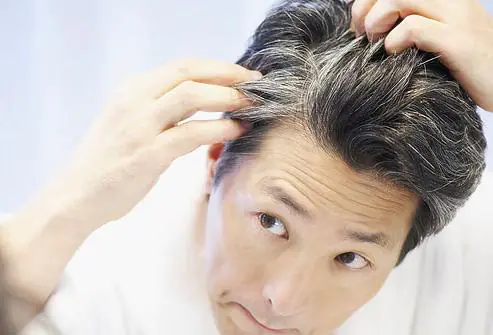
Lack of a hat in winter is also very harmful to hair. Winter in most of Russia is much colder than in Europe. Regular exposure to low temperatures can lead to hair breakage and frequent headaches. This is also one of the factors explaining why hair turns grey. Cold causes blood vessels to constrict, which impairs blood circulation in the scalp. As a result, the activity of the follicles is disrupted, which leads to the appearance of white hairs.
Genetic predisposition
Scientists have not yet established what exactly is not functioning correctly in the body and how to deal with it. But if the immune systems of children and parents are similar, then the processes of pigment loss will also proceed approximately the same. Therefore, if your parents “turned white” at an early age, then you should not torment yourself with the question of why the hair on your head turns gray at the age of 30. This is hereditary and, most likely, you will have to come to terms with it. Of course, there are exceptions to the rule, but you need to be mentally prepared for the fact that your hair will begin to turn gray at the same age as your parents.
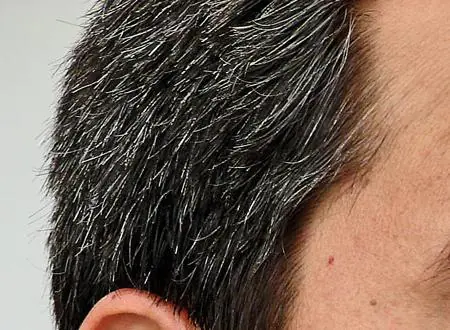
Color type and race
It has long been noted that Caucasians turn white earlier than others. Why does this race's hair turn gray earlier? This is due to the fact that their body initially contains less pigment. The same can be said about blondes. On the other hand, if the hair is already light, then gray hair goes unnoticed for a long time. But for brunettes, even the thinnest hair stands out clearly from the rest. Therefore, as a result, gray hair becomes noticeable in both of them at approximately the same age.
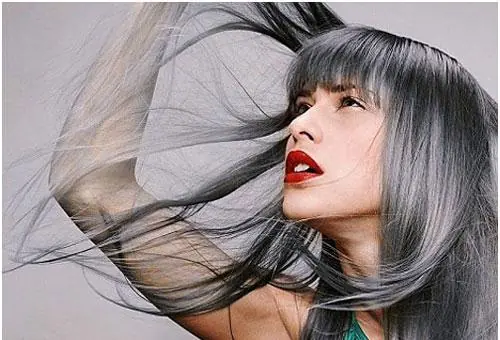
It is very important to understand why the hair on your head turns gray. Only knowledge of the causes will help eliminate or slow down the natural discoloration process. It is also worth remembering that early gray hair is a sign of serious problems in the body (unless it is a hereditary factor), so you should seek help from a specialist. To prevent and slow down the process, it is necessary to exclude all traumatic and unfavorable factors. You need to start eating right, reducing stress levels, normalizing your working hours, and adjusting your work and rest schedule. Then you won't have to worry prematurely.
If trouble does happen, then you need to learn to live with it. In this sense, it is a little easier for men, because whitish hair gives them some charm, they look wise in life, etc. Many actors do not wear makeup and wear their noble gray hair with pride. Women always want to hide their age, so they usually have to resort to various means to help fight gray hair.
Early gray hair is an aesthetic phenomenon when gray hair appears at a young age: up to 25 years in Caucasians, and up to 30 years in people of the Negroid race. By about 40 years of age, hair is almost completely bleached.
Gray hair at an early age, as a rule, is not associated with general aging of the body and is a consequence of unfavorable internal and external factors that disrupt the functioning of melanocyte cells.
Not everyone delves into the root causes of early gray hair, regularly dyes their hair and forgets about the problem, while a symptom may indicate internal pathological changes in the body. Identifying the cause of early gray hair is not easy.
To do this, a person should consult a trichologist, endocrinologist, undergo a study on the level of microelements and vitamins in the hair and blood, as well as the level of thyroid hormones (see also causes of hair loss in women).
What is considered normal?
There is no specific age norm for the onset of gray hair that could be applied to all races and nationalities. In addition to the genetically determined mechanisms of aging, this process is influenced by living conditions, stress, some diseases, etc. Single hairs with altered pigmentation can be found after 30 years, most often on the temples and the front of the head. Almost complete gray hair is observed by the age of 55-60.
Brunettes and brunettes are at risk for earlier graying.
Causes of early gray hair
Graying can develop in three possible ways:
- Physiological, associated with age-related changes in the body and its natural aging (see treatment of hair loss);
- Congenital or leukotrichia, caused by a congenital lack of pigment in the hair shafts;
- Earlier, premature, which develops in young people;
Along the way, graying can be:
- complete, in which the entire hairline loses pigmentation;
- partial (individual hairs or strands turn grey);
- focal (greying in only one area).
As for the mechanism of graying, it is the same for both age and early development: the loss of melanin pigment from the hair shaft occurs. This pigment is synthesized in special cells - melanocytes, which are located in the basal layer of the epidermis, as well as in hair follicles. The cells produce pigment, and it travels from the follicles to the hair shafts.
Stimulation of melanin formation occurs under the influence of mediators of the sympathetic nervous system, pituitary hormones (ACTH, melanocyte-stimulating hormone and β-lipotropin), as well as thyroid hormones and sex hormones.
With the physiological variant of graying, melanocytes age, which produce less and less pigment.
The causes of early gray hair may be related to:
- Some diseases:
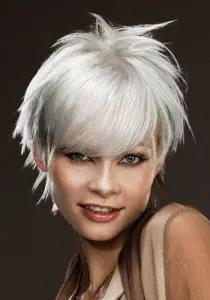
- thyroid dysfunction (autoimmune thyroiditis, hypothyroidism);
- vitiligo;
- iron deficiency anemia;
- atherosclerosis;
- Wardenburg syndrome;
- gastritis with low acidity;
- Werner's syndrome;
- Shingles.
Characteristics of gray hair
The color of the scalp for each person depends on the type of pigment:
- Eumelanin creates black or brown color;
- Pheomelanin is a red or similar shade;
- A lower concentration of pigments is typical for blondes.
Hairs lacking melanin change not only their color, but also their structure. The changes are more noticeable on dark hair than on light hair. The pigment provides elasticity and strength to the hair shaft, protects it from ultraviolet radiation and adverse environmental influences. In addition to discoloration, hair shafts become hard, split, dry, brittle and dull. They are more difficult to care for, i.e. comb and style.
Is there any point in pulling out gray hair?
Some people, in the hope of getting rid of gray hair, begin to pluck them, but this is pointless - a new, identical gray hair will grow in place of the plucked hair. Moreover, you can damage the hair follicles and develop dermatitis.
How to get rid of gray hair
It is impossible to reverse the graying mechanism, but it is quite possible to stop or slow it down. It should be noted that the problem should not be ignored by doctors and be sure to visit a therapist, endocrinologist, trichologist, who will prescribe the appropriate examination and treatment of gray hair.
How to fight gray hair and care for gray hair at home:
- Stop smoking - all heavy smokers have dull and brittle hair;
- Eat well. It is imperative that the diet includes meat, fish, vegetables and fruits;
- Be sure to get enough sleep, 8 hours a day;
- Be a physically active person. Physical inactivity is invariably associated with chronic hypoxia. And cells that do not receive enough oxygen cannot function fully, including melanocytes.
- Limit yourself from stress as much as possible. If this is not possible, take mild sedatives in traumatic situations (valerian tincture or tablets, motherwort, etc.);
- Protect the scalp and hair from temperature changes and ultraviolet radiation;
- Use high-quality cosmetic care products. Recommended products for dry, damaged hair;
- Regularly carry out self-massage of the head using special massagers or a comb with soft teeth;
- Once a week, rub a mixture of castor and burdock oil into the hair roots and leave under a warm towel for 1 hour, then rinse with shampoo;
- Instead of a rinse, you can use infusions of burdock, nettle, chamomile, and birch.
How to fight gray hair with salon treatments:
Salon treatments cannot restore natural color, but they can prevent gray hair or slow down its progression.
- Massage of the scalp. A pleasant procedure activates blood circulation, which means it improves the trophism of melanocyte cells. The procedure is carried out in beauty salons, using various nourishing oils and compositions. It is recommended to undergo 10 procedures once a quarter.
- Microelement mesotherapy, which involves intradermal injection of the scalp with microelement meso-cocktails using special syringes. The drugs are injected to a depth of 2-4 mm, allowing the delivery of useful elements to the area where the hair follicles are located. As a rule, the procedure is preceded by a spectral analysis of hair for microelements, which detects a deficiency of certain substances.
- Nourishing masks and compresses. Special formulations make it possible to restore a healthy appearance and shine to the scalp and hair, improve the structure of the hair shafts, which undergoes changes when graying, and also prepare them for coloring. Wheat germ oil, algae, natural clays, plant extracts, vitamin and microelement essences are used as components for masks (see masks for hair loss).
- Plasmolifting. For this procedure, the patient’s blood is taken, which is specially processed and purified, as a result of which plasma is released from it, without formed elements. Plasma is injected into the scalp using special syringes according to the principle of mesotherapy. It is believed that the procedure triggers the self-healing processes of skin cells, including melanocytes.
How to dye gray hair
This is perhaps the most effective way to disguise loss of hair color.
It should be noted that at least the first time you should seek help from a beauty salon specialist so that the coloring is effective. The choice of dye composition, color, exposure and frequency of dyeing is based on the following factors:
- number of gray hairs;
- hair length and structure;
- growth rate of hair shafts;
- skin type.
Sometimes before dyeing they resort to bleaching in order to achieve uniform coloring of the hair.
- With a small percentage of gray hair on the head (up to 25%), you can resort to tinting or coloring when the changed hair is dyed. The second option is highlighting or blonding, i.e. dyeing gray locks in a light color.
- When changing more than 50% of the hair, complete permanent dyeing with natural or chemical dyes is effective.
- As for the color, the darker it is, the more contrasting and noticeable the gray hair will be as the roots grow. The optimal color is golden; it does not allow gray hair to show through.
What colors really cover gray hair?
On the packaging, the manufacturer often writes “covers gray hair 100%,” but the veracity of these promises can only be verified through personal experience. Professional series of dyes or mixtures prepared by hairdressers in beauty salons, as well as special lines for gray hair from well-known brands (for example, Estelle, Matrix), are considered good. To improve the durability and strength of paint, it is recommended to add 6% professional oxidant to it.
As a rule, good and professional paints are very expensive, and you will have to use them regularly, which not everyone can afford. You can use cheap natural dyes that are safe for frequent use and easy on your wallet.
- To obtain a dark chestnut color, basma and henna are mixed in equal proportions, diluted with water to the consistency of sour cream and applied to the scalp for half an hour. The roots should be painted especially carefully. The paint is washed off with warm water.
- To obtain a soft, natural black color, mix 2 parts basma and 1 part henna, prepare the mixture according to the algorithm above.
It is easier for men to hide gray hair - just have a short haircut without focusing on problem areas of the hair. Women can use asymmetrical and multi-layered haircuts, and arrange their strands so that gray hair is hidden under normal hair.
For a long time it was believed that the appearance of gray hair indicates the decline of the body, a turn from youth to old age. Gray hair? Pull him out quickly! It's time to dispel this myth: gray hair has nothing to do with age!
Trichologist Joe Cincotta participated in a large study in which thousands of volunteers agreed. A group of scientists monitored the subjects’ diet, their lifestyle, the amount of stress and nervous tension, and correlated this with hereditary factors, skin and hair color, gender and age.
The conclusions that scientists have reached are impressive.
Firstly, stress does not play a significant role in the formation of gray hair. Among the study participants were people experiencing very serious life dramas, from the loss of a business to the death of loved ones. None of them showed the appearance or increase in the number of gray hairs immediately after a stressful situation. So the expression “Got gray overnight” is nothing more than a beautiful metaphor.
Secondly, a decrease in the production of melanin, which is responsible for the presence of pigment in the hair, does occur with age, but for each person - at an individual rate, which does not depend on the region of residence, diet, amount of physical activity, or general condition of the body.
Absolutely healthy people sometimes turn gray at the age of 20, and those suffering from severe chronic diseases do not have a single gray hair by the age of 50.
The third conclusion: taking vitamins and dietary supplements is not able to slow down the appearance of gray hair. There is not a single proven effective set of dietary supplements that would stimulate melanin production.
The fourth conclusion: gray hair is in no way interconnected with other processes in the body that are traditionally considered age-related. Neither the appearance of wrinkles on the skin, nor changes in joint and bone tissue, nor the condition of internal organs, nor metabolism - all this has nothing to do with the presence or absence of gray hair.
And finally, plucking gray hairs, early resort to coloring, and any hair and scalp care procedures also do not affect the process of gradual loss of pigment.
The culprit behind the occurrence of gray hair has nevertheless been found: it is a genetic factor. The earlier your parents started going grey, the sooner you are likely to go grey. And on the contrary, if people in your family traditionally began to experience gray hair at a very respectable age, you also don’t have to worry about the early appearance of silver strands.
****
Last year, Spanish scientists also argued that early gray hair is not an aesthetic defect, but a sign of longevity. Scientific experts from Madrid reached these conclusions after conducting a series of studies that examined the relationship between hair color and general health.
During the observations, the medical histories of 5 thousand volunteers aged 30-60 years were studied. Scientists have found that hair color is directly related to the level of a special substance called gluathione in the body. It is necessary for the secretion of pigment, which provides hair color. It is also important that gluathione takes part in protecting the body from such dangerous diseases as cancer, cardiovascular pathologies and Alzheimer's disease. With age, gluathione levels decrease and the risk of developing the above diseases increases.
As a result of these observations, an important result was established: early gray hair indicates that the body does not waste gluathione on the secretion of pigments that provide hair color. Thanks to this, the immune system has the ability to resist dangerous diseases. Therefore, gray hair at 30-40 years old is a sign of good health and longevity.



